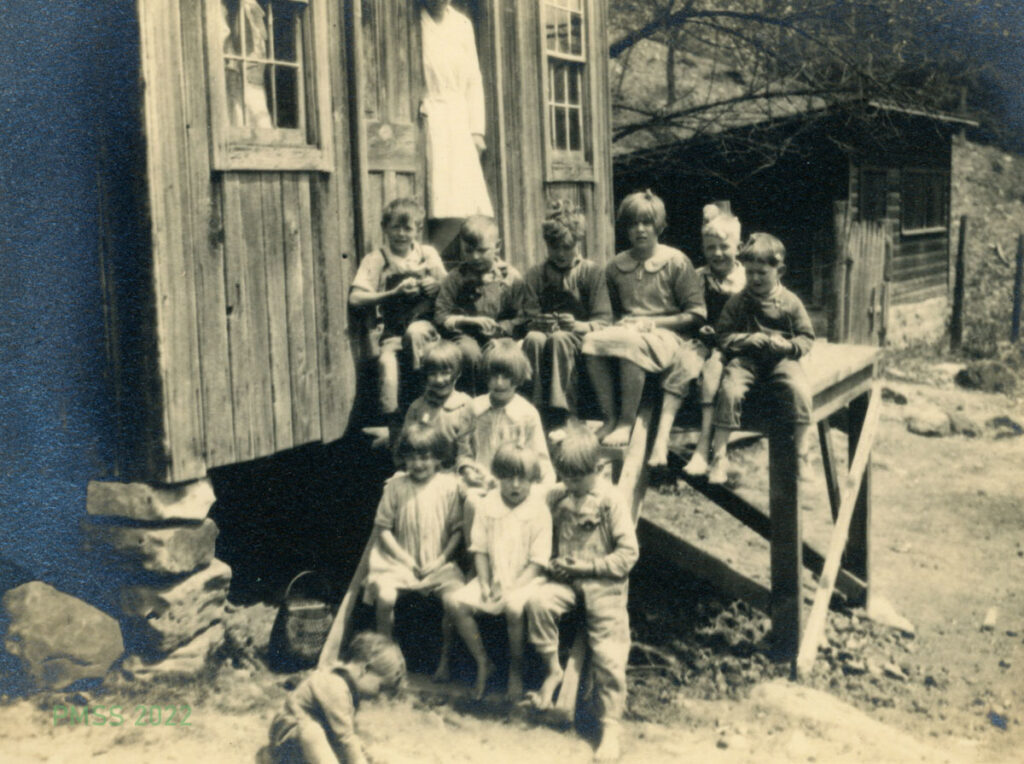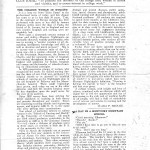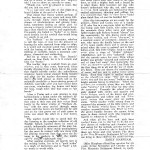Pine Mountain Settlement School
Series 18: PUBLICATIONS RELATED
1920 A Day in a Kentucky Mountain School
By Emily C. Harpham, Line Fork Settlement Teacher

23b 48.11 Children seated on steps, yard, and deck [of Post Office ?] and a woman in the doorway. [motter_margaret_blk_alb_single_023b.jpg]
TAGS: Publications related, 1920, A Day in a Kentucky Mountain School, Emily C. Harpham, College Club of Akron Bulletin
PUBLICATIONS RELATED 1920 A Day in a Kentucky Mountain School by Emily C. Harpham
College Club of Akron: Bulletin, Dec. 17, 1920. Vol. 2, No. 2, pages 1-2
Emily C. Harpham worked as a teacher in Coyl Branch School for six weeks during September and October for Pine Mountain Settlement School’s extension service, Line Fork Settlement. In this article she writes of her experiences. Her article appeared in the December 17, 1920, College Club of Akron Bulletin, a club that seeks to “Promote the interests of the college bred women in Akron and vicinity, and to arouse interest in college work.”
TRANSCRIPTION
001
College Club of Akron
Vol 2. BULLETIN: DECEMBER 17, 1920 No. 2
CLUB IDEAL: “To promote the interests of the college bed women in Akron and vicinity, and to arouse interest in college work.”
A DAY IN A KENTUCKY MOUNTAIN SCHOOL
“Good morning, Elhannon!”
“Howdy! Books?”
“Not yet.”
“Will I have time to go yon to thet air tree to git nuts?”
“Yes. Don’t stay too long.”
Elhannon had lived his 13 years in the first cabin on Line Fork after it leaves the forest-clad divide. The teacher’s first glimpse of him, as she rode into the district the day before school opened, had been a naked white body scampering through the corn at the side of the house, while his sister “battled” on a block his ragged shirt and faded overalls, later to be rinsed in the nearby creek and hung on the fence to dry.
“Good morning, Nancy; I’m glad to see you. We missed you yesterday.”
Nancy is 10 and one of the First Readers.
“I shore wuz sorry to miss books. But I jist hed to seek our kyow. Mammy searched
002
fur hit up Jake’s crick Tuesday an’ seed nary a trace of hit. Yistaday Mam jist hed to git tic beans from the fur mountain patch. We’re aimin’ to hev a bean-stringin’ tonight. Cain’ t you ails come? Somebody will pick the banjo and we’re aimin’ to dance some sets. Mammy said I wuz to shore ax you-alls to come.”
“Thank you; we’ll be pleased to come. But did you find the cow?”
“Yes; way over yon side of the ridge in a laurel thicket at the end of a holler.”
That meant that Nancy walked perhaps 15 miles, barefoot, up very stony and steep hillsides, through lonely trails winding among clumps of rhododendrons and gloomy hemlocks, sometimes finding an easier path by wading a slippery rocked stream, always keeping a close watch for rattlers and copperheads. Frequently she halted to “holler” or to listen more intently for the cowbell that would bring her search to an end.
The “hollerin'” on the mountains, whether to call the cows or just for the pleasure of hearing the echo repeated from ridge to ridge, is a weird and mystical sound that, combined with the baying of the hounds and the soft tinkling of cowbells, makes a mountain symphony, elemental and enchanting.
But let us return to the “B’ar Branch” school on Line Fork, for it is 8 o’clock and time for “books.”
The teacher rings a cowbell from an open window, and in they come, keen-eyed, faces freshly dripping from a hasty dab in the creek that ripples merrily under the schoolhouse windows; hands walnut stained; heads tousled and alive (so the teacher discovered yesterday); ears with almost as much soil as the mountain cornfields — a heart-stirring group of children, especially after you had visited their one-room, windowless, log homes and knew the long, rough miles they had come to “git larnin.’ ”
After a Psalm and a vain attempt to sing harmoniously a hymn under the teacher’s direction, the children choose a “ballet.” Then they come to their own and their voices blend lustily in the minor strains of “Barbara Allen,” with the story carried through many verses until the lovers are buried side by side and an ivy vine grows out of each grave to twine one about the other in a true lovers’ knot.
The teacher would like to spend half the day listening to the complete collection of old English ballads handed down by word of mouth, indisputable witnesses of the pure Anglo-Saxon blood in these sturdy mountaineers, but she must be content with one more with the alluring recurrent lines that carry the listener to the seashore to “ear the waters aglidin’ and the nightingale sing.”
After opening exercises, all eagerly turn to the writing lesson, for to be a “good scribe” is a mark of distinction and to “back” a letter neatly is worthwhile.
Then follow the other subjects, with one book in each to serve a family, for when school attendance is so casual and uncertain it seems hardly necessary to have a book of your own. To be sure, when two or three use the same book at the same time, with lessons on different pages, the consequent noise makes a “blab” school. But we are used to confusion, for any minute Sallie’s Rover, self-appointed Cerberus and always underfoot with a fresh supply of fleas, may growl at the cows, horses, and sheep which poke their heads in the open door, or with a mighty bark and a bound he is after Susie, little Loretta‘s pet pig, who doesn’t understand why she, too, can’t come to school. Both animals are followed by their excited mistresses, shouting and yelling, for it is conceded that “thet air dang dawg would plum finish Suz, ef onct he ketched hit.”
After this interruption we are ready for the primers — Hence and Cassie, two of a family of 11 who live in a one-room cabin up Puncheon Camp; pale little Emily, who comes over the mountain three miles away and whose father makes split hickory bottom “cheers” for the countryside; Si, who knows more about stills than writing, and whose “dag-gone” is a constant source of complaint; Johnnie Cornett, who turns the double letters at the end of his name upside down and is always surprised when the error is pointed out to him; hollow-eyed, thin little Orphie, back to school again after a siege of “chokin’ sickness” (diphtheria), and so very “ashamed” (shy) that she scarcely raises her eyes: Ham, whose mother was greatly “afeared and reckoned the end of time hed come” that memorable day when an aeroplane sailed over Line Fork for the first time — 16 in all and the joy of teacher’s heart. They are shown the combinations of seven. and are sent to gather twice seven leaves. Soon they report to teacher standing on the schoolhouse steps: “One and six are seven; two and five are seven,” holding up the bright autumn leaves to illustrate. When the numbers are correctly given thev are told to make “pretties,” and with what joy they obey the command. Presently the school yard is gaily decked with circles and squares and starry designs, made of the leaves and scarlet bank-berries and yellow and red “blossoms” appear that never grew on earthly stems. When teacher walks among them to commend the attempts of the little artists, and those 16 happy, wistful faces, in the joy of creative accomplishment, are lifted to hers, she grows humble because she cannot bring more to these starved souls who respond so eagerly to whatever is offered.
And when all the boys and girls have trudged home. not to play but to do the evening chores of gathering and chopping wood and caring for the animals, and the teacher is alone with her thoughts, she is thankful that there are brave and wise women. like those at the Pine Mountain Settlement School, who can bring to these children the needful things.
EMILY HARPHAM.
(Miss Harpham offered her services for six weeks during September and October to the Pine Mountain Settlement School, in southeastern Kentucky. She was sent to help in extension work in a very remote rural district. Miss Harpham reports that a wonderful work is being done by the Pine Mountain Settlement School, and that it is especially worthy of interest and support.)
GALLERY
- 001 College Club of Akron: Bulletin: Dec. 17, 1920, Vol. 2 No. 2, page 1. “A Day in a Kentucky Mountain School” by Emily C. Harpham. [a_day_ky_mtns_1920_001.jpg]
- 002 College Club of Akron, Bulletin: Dec. 17, 1920, vol. 2 no. 2, page 2. “A Day in a Kentucky Mountain School. by Emily C. Harpham. [a_day_ky_mtns_1920_002.jpg]
See Also:
EMILY C. HARPHAM Staff
Biography and transcription of her narrative “The Aeroplane Comes to Line Fork.”
PUBLICATIONS RELATED 1922 “Mountain Children in Kentucky” By Lucy E. Halbert
[American Journal of Nursing, Dec. 1922, pp. 212-214.] A Hindman Settlement School nurse describes in her article the conditions in and around Hindman. She also elaborates extensively on the companion settlement school at Pine Mountain and its medical outreach and culture.
Return To:
PUBLICATIONS RELATED Guide



